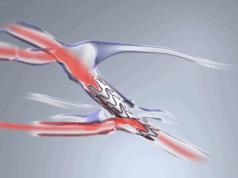
This advertorial is sponsored by Laminate Medical.
Arteriovenous fistula (AVF) creation remains one of the most frequent, yet frustrating procedures performed by vascular surgeons. While AVFs stand as a cornerstone of care for end-stage kidney disease (ESKD) patients, the reality is more than half of AVFs fail to mature without additional interventions.1 The downstream impacts of maturation failure are prolonged central venous catheter (CVC) dependence, procedure fatigue for patients and families, financial penalties for dialysis centers, and increased cost to hospitals, payors, and patients. Over recent decades, multiple basic research teams— including our own—recognized the complex interplay among physical hemodynamic forces, including circumferential wall strain, patient phenotype and vascular remodeling.
Building upon this science, the VasQ extravascular support device (Laminate Medical) was designed as a scaffold to guide AVF remodeling into an optimized configuration to produce a more laminar flow profile, while providing mechanical reinforcement against wall tension from excessive transluminal pressure that can lead to juxta-anastomotic stenosis. VasQ is the first to close this translational gap with a Food and Drug Administration (FDA)-approved product and the clinical research continues to support its adoption.

VasQ’s body of evidence includes 15 peer-reviewed publications to date, all reporting significant patient benefit, including a randomized-controlled trial in the United Kingdom.2 Our group actively participated in several of the U.S. initiatives, and here I provide a high-level overview of three recently published peer-reviewed U.S. studies, which converge to form a compelling, triangulated argument for VasQ’s safety, efficacy and impact in selected patients.
In summary, VasQ patients experienced higher functional success rates at earlier timepoints, as well as reduced intervention rates and reduced CVC exposure at six months when compared to traditional AVF patients.3-5 Each of these three studies fills a distinct and essential gap in our understanding of VasQ’s impact.
Pivotal study: A foundation of safety and efficacy3
Published in the Journal of Vascular Surgery, the U.S. pivotal study by Dillavou et al was a prospective, single-arm, 16-center trial that assessed AVFs created with VasQ in 144 patients. The results demonstrated:
- Excellent safety profile, with no device-related adverse events
- Primary endpoint met: 66% six-month primary patency vs. 55% performance goal (p=0.021)
- 88% functional success (two-needle cannulation) by a median of 56 days in dialysis patients compared to 72% and 81 days in the HFM study1
- 1.07 interventions/patient-year compared to the 1.8 reported for AVFs in the U.S.6
- 68.3% CVC removal by six months compared to 47.2% reported by the USRDS7
- 76.6% cumulative patency at 24 months compared to 53.7% from a recent meta-analysis8
- 0.7% aneurysms and 4.2% steal requiring revision at two years compared to 14% and 9% in literature9
The U.S. pivotal study established that VasQ-supported AVFs can reliably achieve faster, more frequent functional success in the short term, with fewer complications over the longer term.
Matched claims analysis: A broader US concept4
Despite its strengths, the pivotal study lacked a control group for direct comparison. To address this, Lucas et al conducted a matched comparative effectiveness study using Medicare claims data from the same surgeons and institutions that participated in the pivotal study . Key findings from the 144 VasQ patients vs. 782 matched controls included:
- Higher primary patency at six months (66% vs. 36%; odds ratio 3.27; p<0.0001)
- Reduced interventions (0.97 vs. 1.91 per patient-year; p<0.0001)
- Greater functional success at 90 days (43.4% vs. 26.7%; p=0.005) and 180 days (72.5% vs. 53.7%; p=0.004)
- Lower CVC exposure at six months (31.3% vs 47.2%; p<0.001)
Although claims data lack granularity in AVF type or vessel diameter, the scale and rigor of this study provide powerful external validation of VasQ’s benefits in a real-world setting.
Retrospective vessel-matched analysis: Controlling for anatomy5
To complement the matched claims data and address its limitations, Hussain et al next applied the same pivotal study inclusion/ exclusion criteria in a retrospective chart review to generate a control with matched fistula type and vessel diameters from six of the pivotal study centers.
In this direct, site-matched comparison (52 VasQ vs. 52 controls), they found:
- Shorter time to first use (56 vs. 85 days; p=0.04)
- Fewer interventions to support maturation (0.23 vs. 0.51 per patient; p=0.035)
- Higher unassisted functional success at three months (46% vs. 23%; p=0.013) and six months (65% vs. 45%; p=0.03)
- Multivariate analysis identified VasQ implantation as the only factor significantly associated with improved success and reduced reintervention
- Statistical significance was observed for unassisted functional success at three months (p=0.013) and six months (p=0.03). Statistical differences were not observed between any other functional status. These findings not only reinforce the Lucas et al claims study conclusion, but do so while addressing the anatomical and procedural variables that may impact successful AVF creation.

Implications for contemporary practice
Early functional success and reliable long-term accesses correlate with reduced CVC dwell times, fewer infections and lower mortality. The VasQ device addresses core mechanical and hemodynamic vulnerabilities that impede AVF maturation10 by enhancing functional success of one of our worst operations, and has the potential to minimize the need for additional procedures.
In an era that demands value-based care, VasQ not only delivers better clinical outcomes but has the potential to lower system costs by reducing reinterventions and comorbidities that occur with CVC dependence.
And, with the VasQ’s durable inflow regulation, one can speculate that the device may prevent long-term high flow driven complications (cephalic arch stenosis, steal, heart failure, arm edema, etc.).
We finally have a truly novel adjunct to our traditional hemodialysis access creation practices that moves us toward better outcomes, including AVFs that succeed more often, sooner, and with fewer interventions. Certainly, the VasQ device provides us with a real tool to move the hemodialysis access creation field truly toward “catheter last.”
References
- Allon et al. Am J Kidney Dis 2018 May; 71(5):677–689
- Karydis et al. Am J Kidney Dis 2020 Jan; 75(1):45-53
- Dillavou et al. J Vasc Surg. 2023; 78:1302-12
- Lucas et al. J Vasc Access (in press)
- Hussain et al. J Vasc Surg-VI (in press)
- Yang et al. J Vasc Access 2017;18 (Suppl. 2):8-14
- Leake et al. J Vasc Surg 2015; 62:123-7
- Hajibandeh et al. Vascular 2022; 20:1021-33
- Arnaoutakis et al. J Vasc Surg 2017; 66(5):1497-1503
- Bozzetto et al. J Vasc Access 2024; 25(1): 60–70
C. Keith Ozaki, MD, is a vascular surgeon at Mass General Brigham, Harvard Medical School, in Boston.












